As part of my continued deep dive into Splotter titles, I finally got myself a copy of Bus as well. Since I wasn’t sure when I would be able to get it to the table, I started designing another solo mode as I’ve done with Horseless Carriage and Indonesia. It’s still in an early stage and needs tweaking, but already seems quite competitive … which largely is a result of me not being super good at Bus I guess 😀 Anyway, I’ll continue tweaking it, but if someone wants to give it a try and provide feedback I’d be grateful.
Designwise, my hope is that I can keep the rules rather short but still produce similar dilemma and situations as in a multiplayer game such as the automa cutting off the human player, stopping time when it would annoy the human player, but on the other hand not be completely predictable.
Have fun!
Alex
(Latest update Jan 28, 2025)
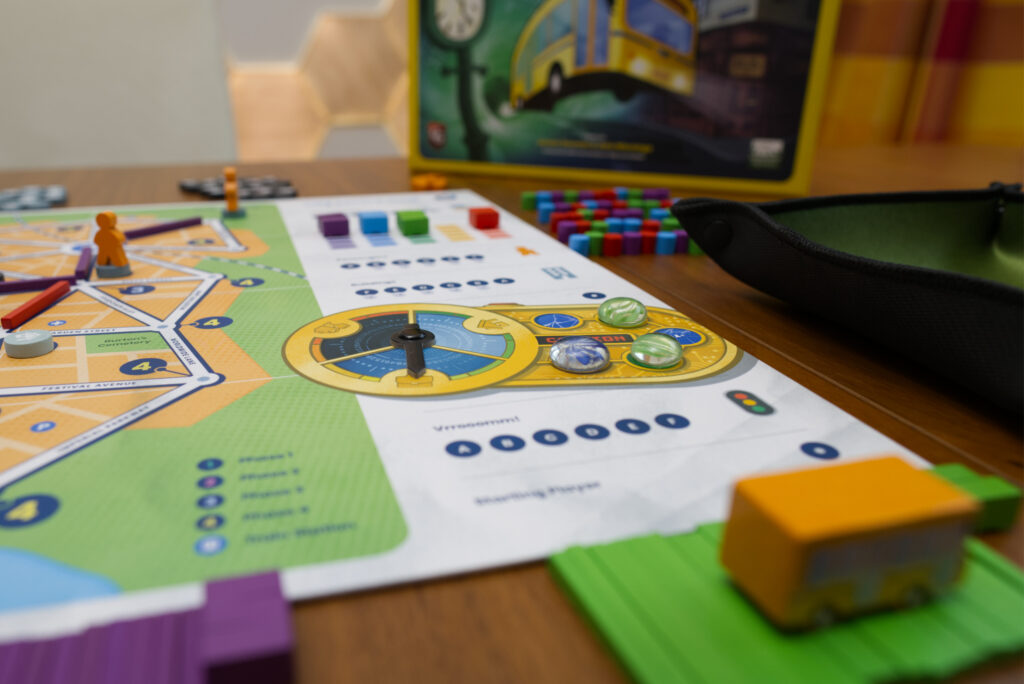
Story
Multiple rivalling bus companies have opened up for business. Their behaviour sometimes makes them look like amateurs, but on the other hand their actions are suspiciously coordinated. They will help each other and actively try to block you.
General Idea
All normal rules apply! You’ll need 2D6, ideally in different colours, called the primary and the secondary die. One is used for the primary decision what the automa wants to achieve and the second for figuring out which of multiple options it will take to do so. You should be able to add any number of automa or even use them when playing with two humans, but I’m mostly testing solo against 3 automa.
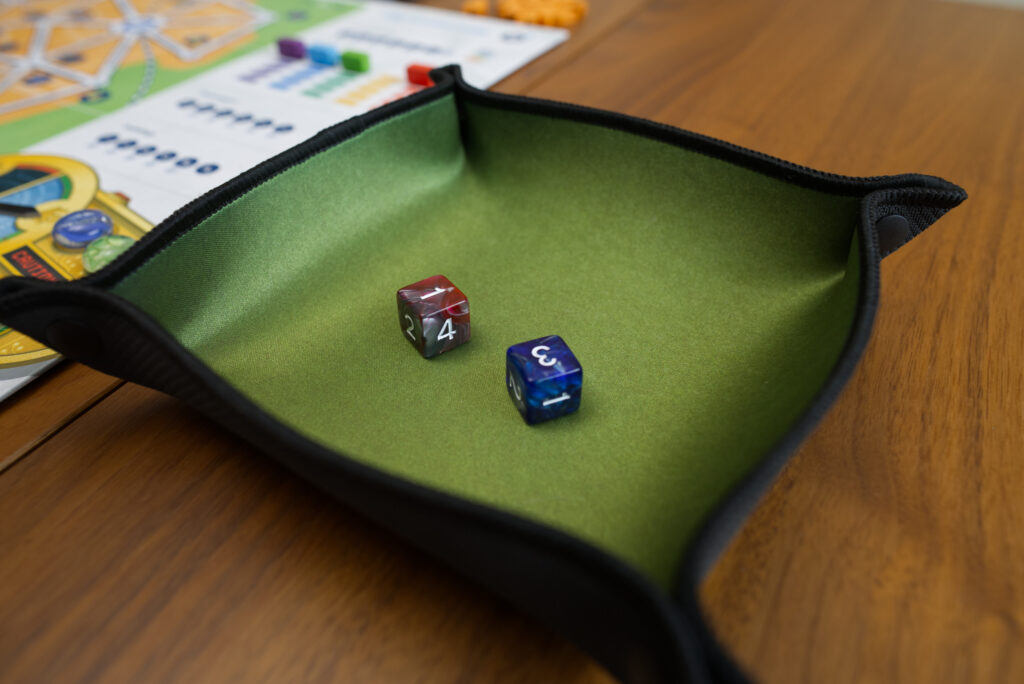
Setup
Set up as normal, pick a number of automa to add (default: 3 automa) and decide on a starting player at random. Mix one of each building type per automa in a bowl (i.e. for 3 automa use three houses, three offices, and three pubs). When it’s an automa’s turn to place a building, roll both dice:
- Primary die: 1-3 west half of the city, 4-6 east half of the city.
- Secondary die: indicates which of the “1” spots in that half is used. Count all empty “1” spots from north to south. If the spot is already filled, use the next space in order.
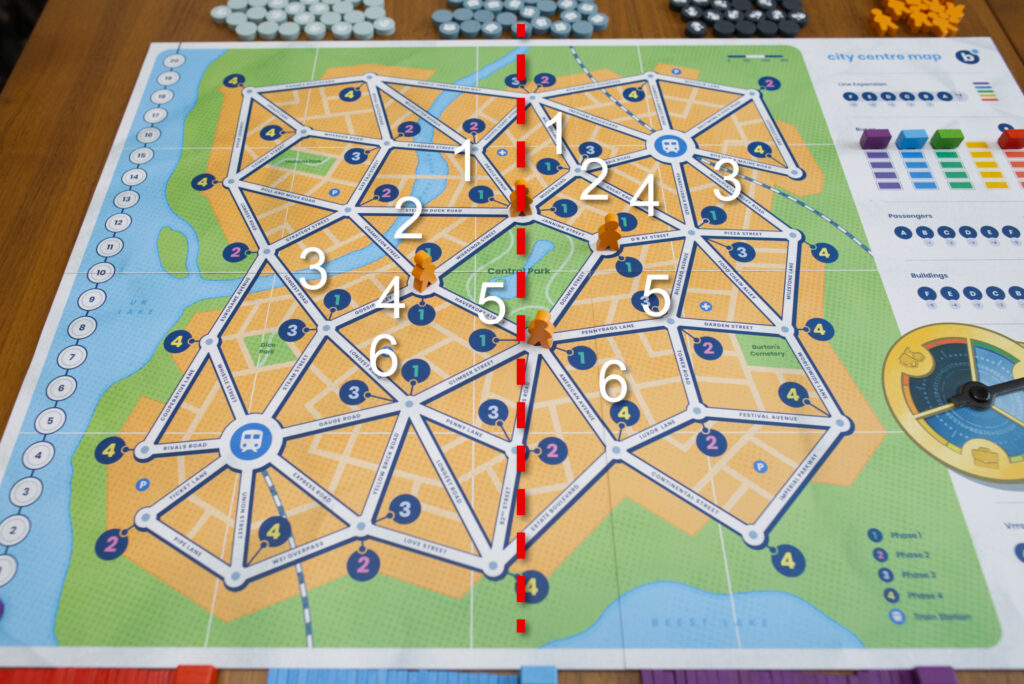
To place the first street, again roll both dice:
- Primary die: This indicates where the street should start. 1 = a home, 2 = an office, 3 = a pub, 4 = passenger, 5 = next to Central Park, 6 = a train station.
- Secondary die: use it to figure out which of the multiple available options (e.g. the automa wants to start next to a pub, assign numbers to each pub and then roll the secondary die).
- Direction: the automa tries to build the street such that it maximises the sum of buildings and passengers connected to the street. If there are multiple options, try to shorten the distance to a train station.
To place the secondary street, again roll both dice:
- Primary die: 1-3 it connects at the north end of its existing street, 4-6 at the south end
- Secondary die: what it tries to connect towards if possible: 1 = home, 2 = office, 3 = pub, 4 = passenger, 5 = Central Park, 6 = train station. If there is no chance to connect to that item from the chosen end, it has no special preference. If there are multiple options that are equally good, again optimise for largest sum of passengers and buildings, then trying to shorten distance to a train station.
Example: The green automa is placing its second street and rolled a 2 on the primary die (= connect to southern end) and 1 on the secondary die (= connect towards a building of type home).
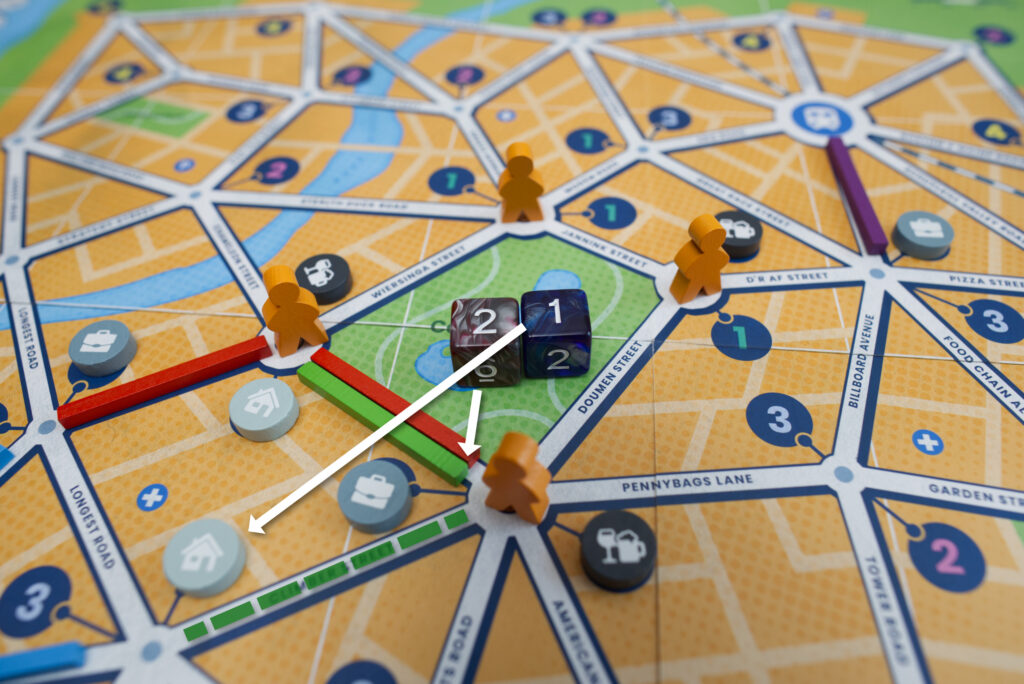
Action Selection
First Action
For their first action in a round, an automa priories more valuable options: it rolls both dice but uses the smaller of both values.
| Die Value | Round 1-3 | Round 4+ |
|---|---|---|
| 1 | Line Expansion | Vroom |
| 2 | Buses | Starting Player |
| 3 | Starting Player | Line Expansion |
| 4 | Buildings | Buildings |
| 5 | Vroom | Clock |
| 6 | Clock | Passengers |
If the selected action is no longer available or would result in a “irrelevant options” (see below), chose the next action in descending order, then ascending (e.g. option 2 was rolled but is already taken, try option 1, if also already taken, try option 3, 4, …)
Subsequent Actions
The automa rolls both dice. The primary die is used to figure out the action, counting from the top (Line Expansion = 1, Buses = 2, …) to the bottom. However, it skips “irrelevant options” (see below) during the enumeration and will not count them. In the unlikely case that all options are relevant, skip passengers (so it’s down to six options).
Example: Since the bus maximum is 1, Line Expansion is no longer a relevant option (placing there would result in an action that does nothing), Buses is already taken, so is Starting Player. Therefore 1 = passengers, 2 = Buildings, 3 = Clock, 4 = Vroom, 5-6= out of range.
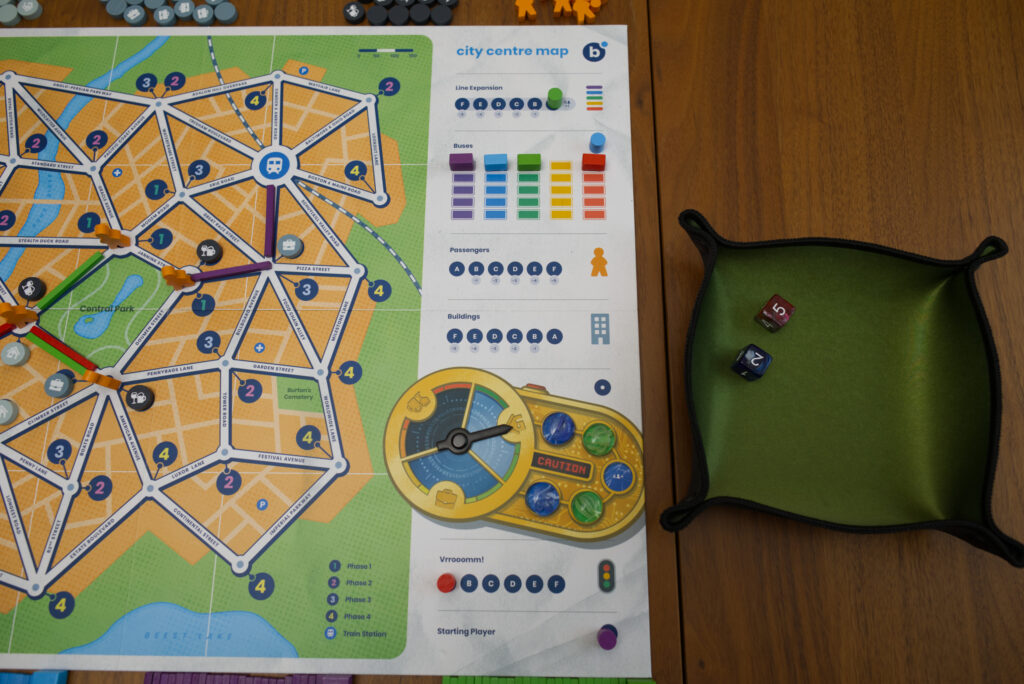
If the primary die value lies outside the range of relevant options (e.g. there are 3 relevant options but a 5 was rolled), use the secondary die’s value instead. If both are out of range, it will take one of the following in that order if it doesn’t have a marker there already:
- Vroom
- Line Expansion
- Buses
If it already has a marker on all of those or they are no longer relevant options, the automa drops out of selecting more actions for this round.
Irrelevant Options
In a number of situations, an automa will consider an action as irrelevant and ignore it for figuring out its priorities:
- Null actions: The automa won’t take an action if it results in a “null action” (e.g. a line expansion spot with a minus value that will result in 0 or less streets). If the Buses action is not yet taken and the bus maximum could still increase, it assumes the limit will increase.
- Buses: skip if the automa already has more buses than all other players (human and automa)
- Passengers: it will skip this action if any automa already has a marker on the action – or – no automa is connected to a train station – or – no station exists that isn’t connected to a human’s bus line – or – on the stations only automa are connected to there are already as much or more passengers than there are different bus lines connected to that station.
- Vroom: the automa already has a marker there
- Starting player: skip if the game will definitely end this round
Action Execution
Line Expansion: The automa uses the least amount of streets to reach in the following order of preference. If none can be reached, it builds towards the closest. If streets are still remaining after it has reached its preference, it repeats the whole process for the remaining streets.
- A building of the current destination (assuming time will not be stopped) that won’t be automatically filled with a passenger that is at that junction.
- A free passenger, i.e. one that isn’t already at its destination, preferably one that is on a human player’s bus line.
- A free building spot of the current phase it isn’t connected to or one for the next higher phase if it is already connected to all free spots of the current phase.
- A train station it isn’t connected to.
Passengers: It will prioritise placing the passengers on a train station it can reach, then the one that takes the most line expansions for any human to reach, then the one most automa can reach. If still ambiguous, it rolls a die to choose at random.
Buildings: The automa uses the following preferences. If there are multiple equally good options, it tries to maximise the distant to any human’s bus line.
- An available spot on its own bus line that no human can reach and where a building of the current destination type (assuming time will not stop) can be placed without being auto-filled by a passenger standing there. If there is already an empty building of the current destination type, instead place a building of the destination type if the clock would be stopped.
- Same as 1. but for another automa’s line (i.e. it helps another automa)
- An available spot on a human’s bus line that has a free passenger. The automa places a building of the current destination type to effective lock in the passenger so the human cannot move it this round.
- The closest (requires least line expansions) available spot to the automa’s line. It places next turn’s destination type (assuming time will not be stopped) in preparation for moving a passenger there next round.
Clock: Roll a D6, on 1-3 stop time, on 4-6 pass as normal. However, the die roll is modified:
- Assuming time will pass normally, go through the markers on the Vroom action in order and count the not already filled buildings a passenger can be delivered to, limiting it by the number of passengers and buses factor for that bus line. If it is an automa, add +1 for each building, if it is a human -1. When counting for the next color, ignore the buildings already assigned a +1/-1 value this way.
- Assuming time will stop, do the same again but use -1 for each building an automa would deliver to and +1 for each human.
Example: Green is first in vroom order. It can reach three offices and there are a sufficient number of free passengers on its line. So these three offices count as +1 each. Next is purple which can reach one office for another +1. Red can reach three offices but one is previously counted by green, so two offices remain for -1 each. One office already has a passenger so it counts as 0. Looking at homes (in case time would stop), all of them already have passengers and thus count as 0. As a result, if an automa has a marker on the clock, the die roll would be modified by a +2, so rolling a 2 or higher will let time pass and rolling a 1 will have it stop.
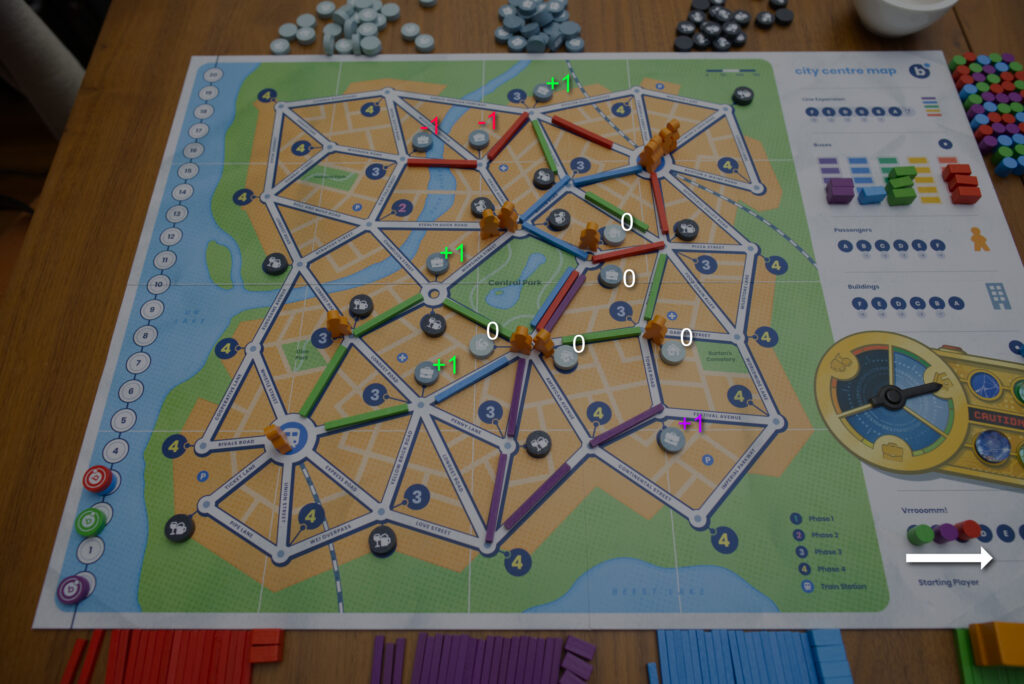
Vroom:
- To select the passenger to move: The automa prefers passengers a human can reach, then those that cannot be reached by an automa but are on a location with a building of next turn’s destination (opening up the junction for delivering there), then those no other automa can reach, then those closest to a human’s bus line (in number of required line expansions).
- To choose their destination: The automa prefers a spot that a human can reach (blocking it for them), then one one (including automa) can reach, then one with the least buildings on them, then farthest distance away from any human (in required line expansions)
End of Round
Put the action markers spent in the current round into a separate pile. This is used to count which round the game is (i.e. for deciding on priorities during first action selection).
Scoring
Score as normal.
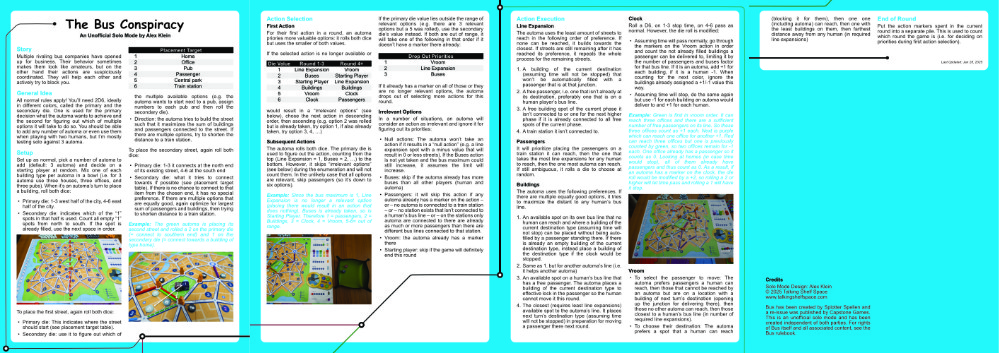
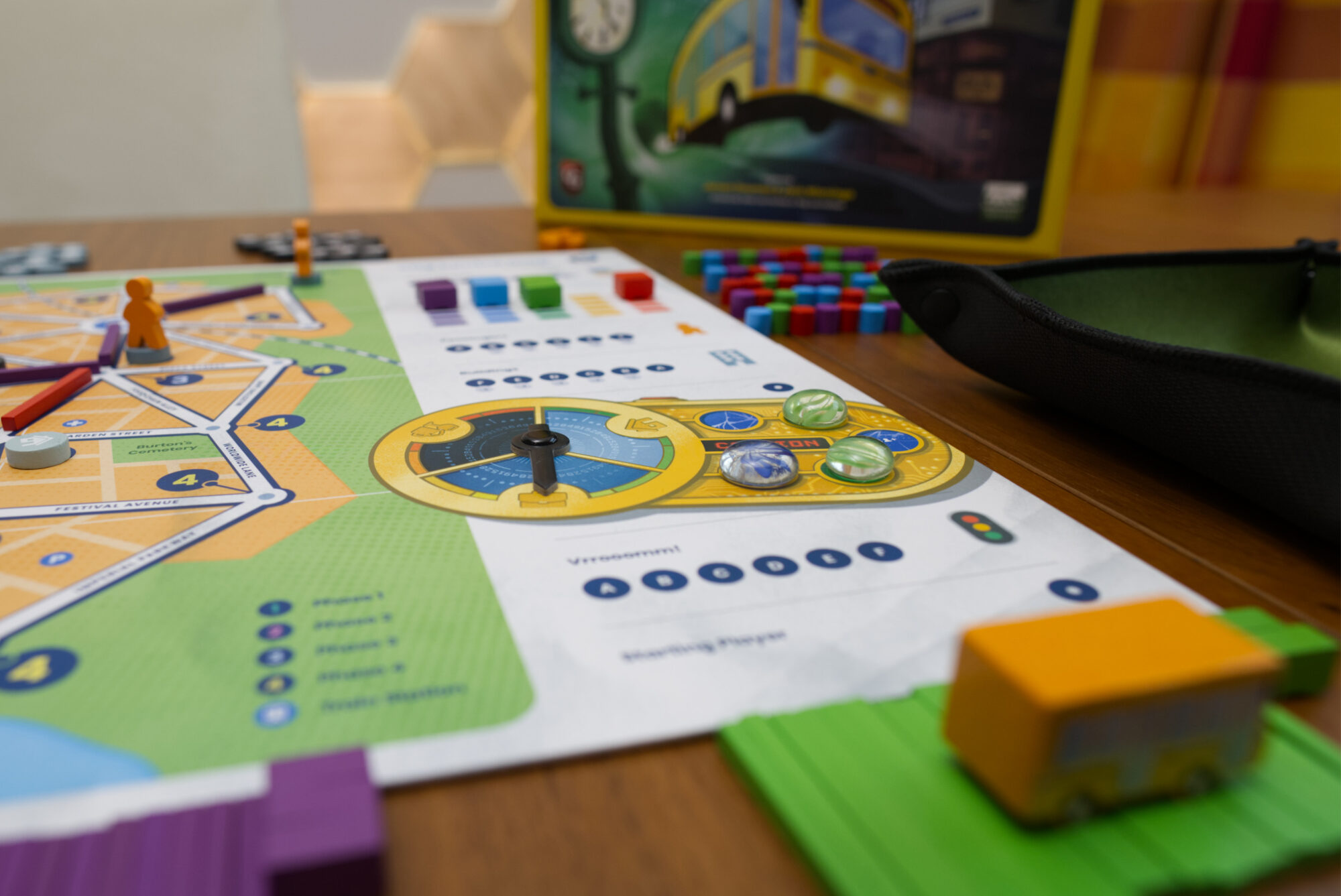
Hi Alex, I have been interested in purchasing BUS, for a long time.
I am very interested in your solo mode, is it worth purchasing because I play solo most of the time?
Thanks for any reply
Len
Hi Len,
that’s difficult to answer, but at the price point Bus is at, I would say no. The automa plays nicely, but I think for the 90€ or so it will take you to get a copy of Bus, you can get two other games that have more long-term replayability like with scenarios to play, etc. I’d rather recommend you check out one of the sites where you can play Bus online and rather play it 2-3 times that way before consider buying a copy. I don’t have any recommendations where to play, but I know there are sites out there.
Thanks for your reply Alex, I agree and I will check out the online version.
All the very best in your endeavours for the future.
Len
Gave it a try today! Really fun. You have to roll a LOT of dice but that’s not too bad. Lost by a point (Ended up using all of my actions in the penultimate round; as in multiplayer, so in solo!)
I think the logic for line expansion and buildings is good, but could use a slight brush up. Thanks for the great mode, had a blast!
https://i.ibb.co/0pG1SdBG/Screenshot-2025-05-28-161143.png
Thanks for the feedback! Glad you enjoyed it 😀